




Are you thinking about your future? Midco® is, and we’re here to get you there faster with multi-gig speeds and ultra-smooth reliability, giving you the power to take on all your tomorrows.1
Let’s go.
Jean Teller / EDITOR
Shelly Bryant / ART DIRECTOR
Leslie Clugston Andres / COPY EDITOR
Alex Tatro / ADVERTISING DESIGNER
Joanne Morgan / ADVERTISING EXECUTIVE JMORGAN@SUNFLOWERPUB.COM
Bill Uhler / PUBLISHER
Bob Cucciniello / DIRECTOR
facebook.com/Sunflower Publishing
From students to faculty, from every school and department on the Hill, researchers at the University of Kansas are lending their expertise to studies near and far.
According to a March 28 Town Talk column in the Lawrence Journal-World, research funding at KU grew to $368.6 million in the 2023 fiscal year, representing an increase of $65 million over the previous year. While quite a few of those grants are related to the new Comprehensive Cancer Center designation, KU is also known as a powerhouse when it comes to funding in other fields of research. And that’s where KU Today & Tomorrow comes in.
With the help of our colleagues at KU News Service, we present articles detailing some of KU’s efforts in different fields.
Taking a look at housing data, a KU professor emeritus of public affairs and administration co-authored a study to see if there are more people looking for homes than there are homes available (page 6). With a closer look at established artificial intelligence systems on page 18, a professor of law hopes to discover how much energy AI uses and its contribution to climate change.
Analyzing the roles of classroom teachers and supportive parents led a KU doctoral student in education and human sciences, a professor of educational psychology, and an assistant professor of educational psychology to conduct a study looking at the sense of belonging felt by students (page 10).
A professor in the music school releases his fifth album of black metal (page 22) while a KU doctoral student/astronomer at the KU ExoLab helps reveal 15 new exoplanets (planets beyond our solar system) in a study co-authored by an associate professor of physics & astronomy (page 14).
Of course, we included a study aimed at the medical field. A grant from the National Institutes of Health will help establish a biomedical center at KU to research big data as it applies to women’s health (page 12) along with research projects by a chemistry professor, an associate and an assistant professor of chemistry, an associate professor of psychology, a professor of sociology and population health, and an associate professor of public affairs and administration.
Our sports article in this issue takes a closer look at a littleseen sport, women’s rowing. Learn more about the women who participate and their hopes for the future after a successful 2023–24 season (page 24), and we’ve included the schedule for KU football as well as partial schedules for both men’s and women’s basketball—the schedule for women’s rowing was unavailable—to help us all gear up for the new seasons this fall and winter. The latter schedules are only partial, as we didn’t have complete information before we sent this issue to the printer.
Turn the page to discover what KU students and professors are doing to extend the knowledge of their various disciplines and extend KU’s reach past the Sunflower State.
Rock Chalk!
KU TODAY AND TOMORROW is a publication of Sunflower Publishing, a division of Ogden Publications, Inc. and Ogden Newspapers of Kansas.
Jean Teller Editor



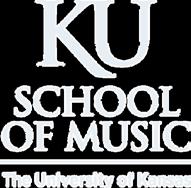
Flexible curriculum tailored for students passionate about music production, technology, and entrepreneurship
Diverse range of commercial genres: from singer/songwriter to video game production
Designed as the ideal pathway for aspiring professionals in popular music
Culminates in a comprehensive portfolio: including original songs, business plans, mixes, and collaborations
Ideal for double majors in other music and creative fields, business, or professional performance

INDUSTRY OPERATIONS & INFRASTRUCTURE
Recording, Touring, Copyright, Publishing, Merchandising, Subscriptions, Budgets, & more!
ARTISTIC & CREATIVE ENDEAVORS
All genres from classical to punk rock to hip-hop
PROFESSIONAL DEVELOPMENT
Personal

KU’s Memorial Campanile & Carillon takes center stage in this shot from KU Marketing.
6
SUPPLY IS NOT THE ISSUE
Study finds US does not have housing shortage, but shortage of affordable housing.
8 BELONGING EQUALS SUCCESS
Clear instruction, parental support predict students’ sense of school connectedness.
12 GRANTS SPUR RESEARCH
KU establishes $11 million biomedical center to advance women’s health using big data.
With wobbling stars, astronomers gauge the mass of 126 exoplanets and find 15 new ones.
18
AI AND THE ENVIRONMENT
Study: AI writing, illustration emit hundreds of times less carbon than humans.
22 SCREAMIN’ FOR HIS SUPPER
Professor applies theoretical work to his metal music.
24
READY ALL, ROW!
KU’s women’s rowing crew looking forward to 2024–2025 season.
on the cover
The KU flag flies in the Kansas breeze. Photograph courtesy Meg Kumin/KU Marketing.
.
At least, that’s the case according to common belief — and is even the basis for national policy, as the Biden administration has stated plans to address the housing supply shortfall.
Study finds US does not have housing shortage, but shortage of affordable housing.
ARTICLE BY Mike Krings, KU News Service
But new research from the University of Kansas finds that most of the nation’s markets have ample housing in total, but nearly all lack enough units affordable to low-income households.
Kirk McClure, professor of public affairs & administration emeritus at KU, and Alex Schwartz of The New School co-wrote a study published in the journal Housing Policy Debate (https://doi.org/10.1080/10511482.2 024.2334011). They examined U.S. Census Bureau data from 2000 to 2020 to compare the number of households formed to the number of housing units added to determine if there were more households needing homes than units available.
The researchers found only four of the nation’s 381 metropolitan areas experienced a housing shortage in the study time frame, as did only 19 of the country’s 526 “micropolitan” areas — those with 10,000–50,000 residents.
The findings suggest that addressing housing prices and low incomes is more urgent than simply building more homes, the authors write.
“There is a commonly held belief that the United States has a shortage of housing. This can be found in the popular and academic literature and from the housing industry,” McClure says. “But the data shows that the majority of American markets have adequate supplies of housing available. Unfortunately, not enough of it is affordable, especially for low-income and very low-income families and individuals.”
McClure and Schwartz also examined households in two categories: very low income, defined as between 30% and 60% of area median family income, and extremely low income, with incomes below 30% of area median family income.
The numbers showed that from 2010 to 2020, household formation did exceed the number of homes available. However, there was a large surplus of housing produced in the previous decade. In fact, from 2000 to 2020, housing production exceeded the growth of households by 3.3 million units. The surplus from 2000 to 2010 more than offset the shortages from 2010 to 2020.
The numbers also showed that nearly all metropolitan areas have sufficient units for owner occupancy. But nearly all have shortages of rental units affordable to the very low-income renter households.
While the authors looked at housing markets across the nation, they also examined vacancy rates, or the difference between total and occupied units, to determine how many homes were available. National total vacancy rates were 9% in 2000 and 11.4% by 2010, which marked the end of the housing bubble and the Great Recession. By the end of 2020, the rate was 9.7%, with nearly 14 million vacant units.
“When looking at the number of housing units available, it becomes clear there is no overall shortage of housing units available. Of course, there are many factors that determine if a vacant is truly available; namely, if it is physically habitable and how much it costs to purchase or rent the unit,” McClure says. “There are also considerations over a family’s needs such as an adequate number of bedrooms or accessibility for individuals with disabilities, but the number of homes needed has not outpaced the number of homes available.”
Not all housing markets are alike, and while there could be shortages in some, others could contain a surplus of available housing units. The
study considered markets in all corebased statistical areas as defined by the Census Bureau. Metropolitan areas saw a nationwide surplus of 2.7 million more units than households in the 20-year study period, while micropolitan areas had a more modest surplus of about 300,000 units.
Numbers of available housing units and people only tell part of the story. An individual family needs to be able to afford housing, whether they buy or rent. Shortages of any scale appear in the data only when considering renters, the authors write. McClure and Schwartz compared the number of available units in four submarkets of each core-based statistical area to the estimated number of units affordable to renters with incomes from 30% to 60% of the area median family income. Those rates are roughly equivalent to the federal poverty level and upper level of eligibility for various rental assistance programs. Only two metropolitan areas had shortages for very-lowincome renters, and only two had surpluses available for extremely-lowincome renters.
Helping people afford the housing stock available would be more cost effective than expanding new home construction in the hope that additional supply would bring prices down, the authors write. Several federal programs have proven successful in helping renters and moderate-income buyers afford housing that would otherwise be out of reach.
“Our nation’s affordability problems result more from low incomes confronting high housing prices rather than from housing shortages,” McClure says. “This condition suggests that we cannot build our way to housing affordability. We need to address price levels and income levels to help low-income households afford the housing that already exists, rather than increasing the supply in the hope that prices will subside.”


ARTICLE BY Mike Krings, KU News Service
A NEW STUDY FROM THE UNIVERSITY OF KANSAS has analyzed the roles classroom interaction and parental support play in school connectedness for K–12 students, finding clearly communicated instruction in class and support from parents are closely linked with belonging.
The study found students who feel their teachers provide good classroom management felt supported by those teachers and that they belong in their school. Those who felt they had more support from their parents also felt like they belonged in school, but parent support did not predict feelings of teacher support. Understanding the links between support and school connectedness can help students succeed as well as help schools and teachers use practices that foster belonging, according to the researchers.
Anqi Peng, doctoral student in KU’s School of Education & Human Sciences, has a scholarly interest in student-school connections. She began this research journey by studying school outcomes for students who are learning English as a second language while being educated in English-only classes in American schools.
“It made me think a lot about identity and how students felt about school connection and if they felt they were supported,” Peng says. “And I found there wasn’t much research into how we can foster school connectedness. Research had shown that school connectedness decreases during

adolescence, but not necessarily why or how we can facilitate it. That’s what we’re hoping to learn more about.”
For the study, authors analyzed data from 4,838 high school students in the United States from the 2018 Programme for International Student Assessment. Students in the data set expressed how much support they felt in a variety of school and family factors. For school they specifically examined classroom management, instructional support, and emotional support. The students were also asked about how much parental support they felt.
Results showed classroom interactions to be the factor that most predicted teacher support and belonging to school. Especially in terms of classroom management, students who felt their teachers managed class well by minimizing classroom disruptions had a higher sense of connection to their schools. Instructional support, in which students felt teachers set clear goals and adapted lessons to fulfill students’ learning needs, also positively predicted teacher support, but emotional support was not related to teacher support or school belonging.
The study, co-written by Peng; Meagan Patterson, professor of educational psychology; and Sean Joo, assistant professor of educational psychology, all of KU, was published in the Journal of Youth and Adolescence (https://link.springer.com/ article/10.1007/s10964-023-01908-1).
Cognitive study shows lack of bilingual education adversely affects English language learners’ writing skills: https://news.ku.edu/news/ article/2021/10/13/cognitive-studyshows-lack-bilingual-educationleads-students-learning-writeenglish
Study examines role of working memory, cognitive functions in English learners learning to write: https://news.ku.edu/news/ article/2023/10/17/studyexamines-role-working-memorycognitive-functions-englishlearners-learning-write
Study finds empathy training improves mother-child relationships, life satisfaction: https://news.ku.edu/news/ article/2022/05/06/study-findsempathy-training-improves-motherchild-relationships-life-satisfaction
“I think this study shows the importance of classroom management and instructional support and that their impact may have been underestimated, compared to emotional support from teachers,” Patterson says. “I feel that’s an important area of focus for future research. We also know that how students feel about school is not static, so we’d like to look at if this changes over time.”
“Teacher support is more related to specific behaviors in the classroom. Parental support is more related to school connectedness in general,” Peng says. “We are looking at both feelings of support from teachers in a certain class and school belonging in general. Students move through classes throughout the day, so we wanted to see a bit more about how these things fit together.”
Students were asked about their feelings of in-class interactions during their English classes.
“There is a certain emotional vulnerability that comes up in English class that we thought might make English classes especially important for how students feel in relation to their school,” Patterson says.
The authors say more understanding of what fosters school connectedness can help schools, teachers, and families provide more developmentally appropriate supports necessary to help students feel like they connect to their schools, as well as demonstrate the importance of higher education to prepare teachers who are skilled at classroom management and instructional support. The study is part of Peng’s larger body of work on bilingual education and cognitive function in learning and Patterson’s research in parent-child relationships.
The authors hope to build on the research by gauging students’ feeling of connection over time, or throughout a school year.
“We need much more information on how school connectedness could be fostered,” Peng says. “But this does highlight the importance of parental support and especially effective classroom management and how expressing clear expectations in teaching can foster connection.”





KU establishes $11 million biomedical center to advance women’s health using big data.
ARTICLE BY Brendan Lynch, KU News Service
A NEW $11.3 MILLION GRANT from the National Institutes of Health will establish a multidisciplinary biomedical center at the University of Kansas to research big data’s potential to improve women’s health.
The award is a component of the NIH Institutional Development Award Program and will be KU’s fifth Center of Biomedical Research Excellence (COBRE; www.nigms.nih.gov/Research/DRCB/IDeA/pages/ COBRE.aspx) since the program’s inception in the 1990s.
“This is part of NIH’s EPSCoR (Established Program to Stimulate Competitive Research) effort to enhance research in states like Kansas that historically have received a smaller portion of the pie,” says principal investigator Heather Desaire, University Distinguished Professor and Keith D. Wilner Chair in Chemistry at KU, who will serve as the center’s director. “We’re going to leverage big data to improve women’s health. All of the research projects within the center will have a component of using large data sets or machine learning, and an application area related to women’s health in some way — especially looking at health disparities that women incur. We’re talking about diseases like ovarian cancer, breast cancer, multiple sclerosis and Alzheimer’s disease, which are more prevalent in women.”
“Big data” is defined as large and complex data sets, particularly those from new sources.
By funding research projects, supporting faculty, improving lab facilities, and boosting collaboration across scholarly fields, the center will harness complex datasets to tackle biomedical issues vital to women. The leading collaborators at KU come from a range of laboratory sciences as well as behavioral and social sciences.
Five KU faculty will lead biomedical research projects, each of which could serve as a springboard to further funding opportunities. The research project leaders are Rebecca Whelan, associate professor of chemistry; Meredith Hartley, assistant professor of chemistry; Amber Watts, associate professor of psychology; Jarron Saint Onge, professor of sociology and population health; and Misty Heggeness, associate professor of public affairs & administration and associate research scientist at KU’s Institute for Policy & Social Research.
Additionally, the new grant will support three new tenure-track faculty hires at KU in the departments of chemistry, psychology and sociology, whose research will focus on the intersection of big data and biomedical research benefiting women. A Research-Engaged Faculty Fellows Program also will be established under the grant.
The new center at KU will expand education and training of students in handling complex datasets as well.
“Psychology is leading the charge in developing a data science curriculum at KU,” Desaire says. “They’re very tied into this grant, and that will be an area where there will be synergy in teaching and training students.”
Moreover, the Kansas Board of Regents has awarded the new center matching funds earmarked toward training students in data science, boosting the state’s workforce in the burgeoning field.
The researchers, students, and faculty involved will be backed by a new Biomedical Datasets and Services Core Lab (https://research. ku.edu/ku-core-research-labs) at KU supported under the NIH award that will serve other research efforts at KU and even private industry, too.

“This core lab is run by Donna Ginther (Roy A. Roberts and Regents Distinguished Professor of Economics at KU) and will focus on biomedical data sets, which is a new expansion of the scope of her center’s past work,” Desaire says.
The Datasets and Services core will be run under the umbrella of the Institute for Policy & Social Research, a center Ginther heads at KU.
“The five project leaders will be served by the datasets core, as will anybody in the entire KU community who needs statistics support, dataset analysis or help finding a dataset relevant to a project they are pursuing,” Desaire says.
The multimillion-dollar economic boost to Kansas through direct spending and new research positions is just one way the center will benefit the region. Planned research also will draw data from regional communities that often find themselves overlooked in biomedical studies. For instance, according to Desaire, most clinical trials operate out of city hospitals, leaving women living in rural communities under-researched.
“If you live out in western Kansas, the chances of you participating in those types of things are smaller,” says the KU researcher. “Sometimes it’s a matter of having somebody specifically ask the question, ‘How do you know these health factors impact somebody’s overall health in rural settings versus urban settings — where we have most of the data from?’”
Heggeness, one of the project leaders, will focus on telemedicine, another growing means to provide health care to people in less populated areas of the state.
“The telemedicine project is specifically addressing rural health issues that are relevant to Kansas,” Desaire says.
The final objective of the Centers of Biomedical Research Excellence program is to train and retain highly qualified faculty so that even beyond the COBRE funding, new ideas can be launched and developed in states like Kansas.
“My very first grant funding was a research project on Bob Hanzlik’s COBRE grant here at KU in 2002,” Desaire says. “The program was invaluable in my development as a grant-funded scientist. Now, over 20 years later, it’s exciting to get to pay it forward and help other faculty accelerate their research.”
“My very first grant funding was a research project on Bob Hanzlik’s COBRE grant here at KU in 2002. The program was invaluable in my development as a grant-funded scientist. Now, over 20 years later, it’s exciting to get to pay it forward and help other faculty accelerate their research.”
–Heather Desaire
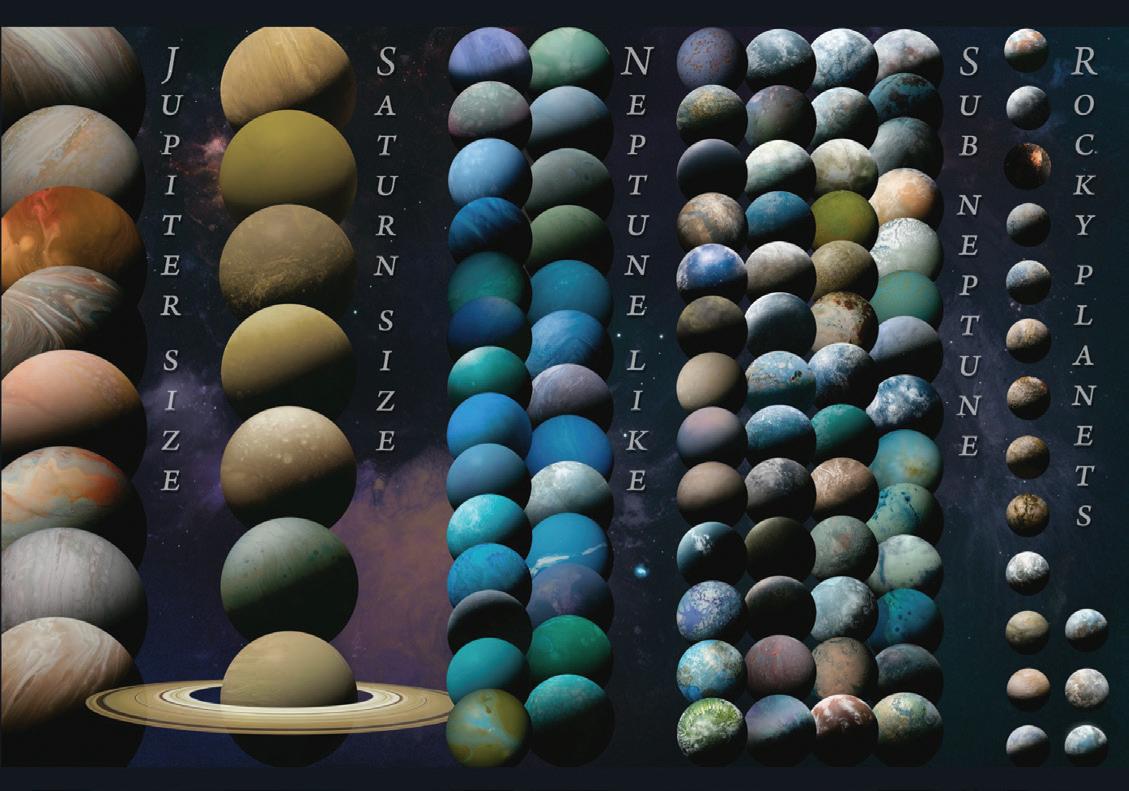
Artist’s rendition of a variety of exoplanets featured in the new NASA TESS-Keck Survey Mass Catalog, the largest, single, homogeneous analysis of TESS planets released by any survey thus far.
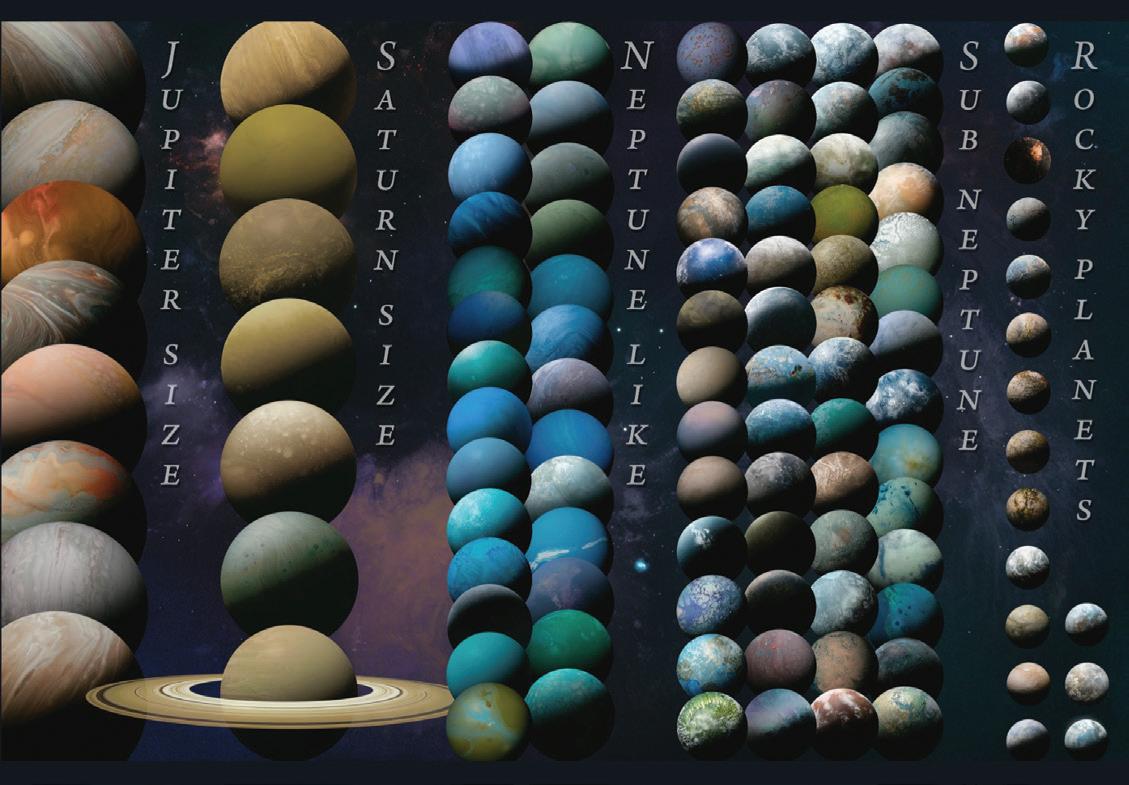
With wobbling stars, astronomers gauge the mass of 126 exoplanets and find 15 new ones.
ARTICLE BY Brendan Lynch, KU News Service
USING DATA from the Transiting Exoplanet Survey Satellite (https://science.nasa.gov/mission/tess) and W.M. Keck Observatory (www.keckobservatory.org) on Mauna Kea in Hawaii, an astronomer at the University of Kansas led a study revealing 15 new exoplanets (planets beyond our solar system) along with the mass of 126 other exoplanets. The findings give astronomers new understanding of the makeup of exoplanets and their star systems generally.
The study cataloging the exoplanets — comprising severe and exceptional environments, some of which hold promise to support life — was conducted under auspices of the TESS-Keck Survey and appears in The Astrophysical Journal Supplement (https://iopscience. iop.org/article/10.3847/1538-4365/ad4484).
“These two facilities (TESS and Keck) work synergistically to study exoplanets,” says lead author Alex Polanski, doctoral student in physics & astronomy at KU, where he works at the KU ExoLab, a research group dedicated to the discovery and characterization of nearby planetary systems. “TESS is a satellite orbiting above Earth’s atmosphere, scanning the sky for exoplanets using the transit method.”
This transit method involves observing a planet as it passes in front of its host star, causing a slight dimming of the star’s light.

“By detecting and measuring these transit events, researchers can determine the planet’s orbital period and size,” Polanski says. “Larger planets block more light, making them easier to detect. However, transit data doesn’t provide information about the planet’s mass, which is crucial for understanding its composition.”
To determine the mass of exoplanets, researchers used the Keck Observatory to execute a technique called “radial velocity,” according to Polanski.
“This method involves observing the host star and measuring its spectrum,” he says. “Stars contain elements like hydrogen, helium, and iron, which create characteristic absorption lines in their spectra. As a planet orbits its star, the star experiences slight gravitational pull, causing it to wobble. This wobble shifts the star’s spectral lines due to the Doppler effect — similar to how a siren’s pitch changes as it moves towards or away from you. The amount of shift in the spectral lines is related to the planet’s mass; larger planets cause greater shifts.”
The KU researcher says radial velocity was used to discover the first exoplanets around sun-like stars in the 1990s, known as “hot Jupiters” — massive Jupiter-sized planets with short orbital periods of about 10 days. However, smaller planets, especially those between Earth and Neptune in size, create much smaller shifts and need more sensitive instruments like those at Keck.
“The TESS-Keck Survey represents the single largest contribution to understanding the physical nature and system architectures of new planets TESS has discovered,” says Ian Crossfield, associate professor of physics & astronomy at KU, who leads KU’s ExoLab and co-wrote the new paper. “Catalogs like this help astronomers place individual worlds in context with the rest of the exoplanet population.”
Indeed, beyond KU or Keck, a global team of astronomers from multiple institutions spent three years developing the catalog; they took TESS planetary data and analyzed 9,204 radial velocity measurements, 4,943 of which were recorded over the course of 301 observing nights using Keck Observatory’s planet-hunting instrument called the HighResolution Echelle Spectrometer.
“With this information, along with the planets’ radii, scientists can estimate the planets’ densities and infer their
possible compositions,” Polanski says. “This paper is the largest of its kind to date. The last similar one that came out was, I think, a sample of 27 exoplanets. This is up to 126 planets.”
The team say two planets — dubbed TOI-1824 b and TOI1798 c — are so bizarre they might deepen astronomers’ grasp of planetary diversity and evolution in general.
One of the densest sub-Neptunes in the catalog, TOI-1824 b, has incredible mass for a planet of its size.
“At nearly 19 times the mass of Earth, but only 2.6 times the size of our home planet, TOI-1824 b is an exoplanet oddity,” says co-author Joseph Murphy, doctoral student at the University of California-Santa Cruz. “Planets similar in size typically have a mass between roughly 6 and 12 times the mass of Earth.”
TOI-1798 is an orange dwarf, or K-type star, that has two planets: TOI–1798 b, a sub-Neptune that has an orbit of about eight days, and TOI–1798 c, a super-Earth that is so close to its host star, it makes one orbit in less than 12 hours. It’s one of only a few star systems believed to feature an inner planet with an ultra-short period (USP) orbit.
“While the majority of planets we know about today orbit their star faster than Mercury orbits the Sun, USPs take this to the extreme,” Crossfield says. “TOI-1798 c orbits its star so quickly that one year on this planet lasts less than half a day on Earth. Because of their proximity to their host star, USPs are also ultra-hot— receiving more than 3,000 times the radiation that Earth receives from the Sun. Existing in this extreme environment means that this planet has likely lost any atmosphere that it initially formed.”
Polanski says a better knowledge of exoplanets and their star systems would give us a better understanding of our own solar system.
“Astronomy has gone through several phases of ‘great demotions,’” he says. “We used to believe Earth was the center of the universe. Then we learned it isn’t even the center of the solar system. From there, we discovered Earth is just one planet among many in a galaxy, which is one among billions of galaxies. However, our solar system might be more unique than we thought. About half of all Sun-like stars have a binary companion. Our Sun does not. Only about 10% of Sun-like stars have gas giants like Jupiter or Saturn. This suggests our solar system might be less typical than we assumed.”
“About half of all Sun-like stars have a binary companion. Our Sun does not. Only about 10% of Sun-like stars have gas giants like Jupiter or Saturn. This suggests our solar system might be less typical than we assumed.”
–Alex Polanski





Study: AI writing, illustration emit hundreds of times less carbon than humans.
ARTICLE BY Mike Krings, KU News Service
WITH THE EVOLUTION of artificial intelligence comes discussion of the technology’s environmental impact. A new study has found that for the tasks of writing and illustrating, AI emits hundreds of times less carbon than humans performing the same tasks. That does not mean, however, that AI can or should replace human writers and illustrators, the study’s authors argue.
Andrew Torrance, Paul E. Wilson Distinguished Professor of Law at KU, is coauthor of a study comparing established systems such as ChatGPT, Bloom AI, DALL-E2, and others when completing writing and illustrating tasks to those completed by humans.
Like cryptocurrency, AI has been subject to debate about the amount of energy it uses and its contributions to climate change. Human emissions and environmental impact have long been studied, but comparisons between the two have been scant.
The authors conducted a comparison and found that AI systems emit between 130 and 1,500 times less CO2e (carbon dioxide equivalent) per page of text generated than human writers and illustration systems between 310 and 2,900 times less CO2e per image than humans.
“I like to think of myself as driven by data, not just what I feel is true. We’ve had discussions about something that appears to be true in terms of AI emissions, but we wanted to look at the data and see if it truly is more efficient,” Torrance says. “When we did it, the results were kind of astonishing. Even by conservative estimates, AI is extremely less wasteful.”

To calculate the carbon footprint of a person writing, the researchers consulted the Energy Budget, a measure that considers the amount of energy used in certain tasks for a set period of time. For example, it’s well established how much energy a computer with word processing software uses per hour. When multiplied by the average time it takes a person to write a page of text of 250 words, an estimate can be arrived at. Using the same amount of energy used by the CPUs that operate AI such as ChatGPT, which can produce text much faster, produces an estimate for AI.

The study, co-written with Bill Tomlinson, Rebecca Black, and Donald Patterson of the University of California-Irvine, was published in the journal Nature (www.nature.com/articles/ s41598-024-54271-x).
Researchers also considered per capita emissions of individuals in the United States and India. Residents of the former have approximate annual emissions of 15 metric tons CO2e per year, while the latter is an average of 1.9 metric tons. The two nations were chosen as they have the highest and lowest respective per capita environmental impact of countries with population higher than 300 million, and to provide a look at different levels of emissions in different parts of the world in comparison to AI.
Results showed that Bloom AI is 1,400 times less impactful than a U.S. resident writing a page of text and 180 times less impactful than a resident of India.
In terms of illustration, results showed that DALL-E2 emits approximately 2,500 times less CO2e than a human artist and 310 times less than an India-based artist. Figures for Midjourney were 2,900 times less for the former and 370 times less for the latter.
As technologies improve and societies evolve, those figures are almost certain to change as well, Torrance says.
The authors write that carbon emissions are only one factor to consider when comparing AI production to human output. As the technologies exist now, they are often not


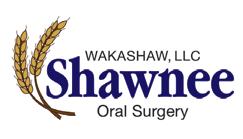
capable of producing the quality of writing or art that a human can. As they improve, they hold the potential to both eliminate existing jobs and create new ones. Loss of employment has potential for substantial economic, societal, and other forms of destabilization. For those and other reasons, the authors write, the best path forward is likely a collaboration between AI and human efforts, or a system in which people can use AI to be more efficient in
“We don’t say AI is inherently good or that it is empirically better, just that when we looked at it in these instances, it was less energy consumptive.”
–Andrew Torrance
their work and retain control of final products.








Legal issues such as the use of copyrighted material in training sets for AI must be considered, the authors write, as does the potential for an increase in artificially produced material to result in an increase in the energy it uses and resulting emissions. Collaboration between the two is the most beneficial use of both AI and human labor, the authors write.

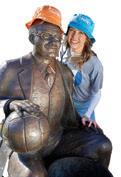



“We don’t say AI is inherently good or that it is empirically better, just that when we looked at it in these instances, it was less energy consumptive,” Torrance says.
The research was conducted to improve understanding of AI and its environmental impact and to address the United Nation Sustainable Development Goals of ensuring sustainable consumption and production patterns and taking urgent action to combat climate change and its impacts, the researchers write.
For their part, the authors have begun to use AI as an aid in producing drafts for some of their writing, but they also agree on the necessity of carefully editing and adding to such drafts manually.
“This is not a curse, it’s a boon,” Torrance says of AI. “I think this will help make good writers great, mediocre writers good, and democratize writing. It can make people more productive and can be an empowerment of human potential. I’m hugely optimistic that technology is getting better in most respects and lightening the effects we have on the Earth. We hope this is just the beginning and that people continue to dig into this issue further.”









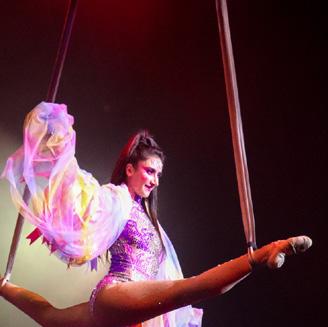


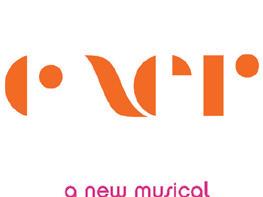


Professor applies theoretical work to his metal music.
ARTICLE BY Rick Hellman, KU News Service
PEOPLE SAY TO BRAD OSBORN ALL THE TIME: You seem like such a nice, clean-cut fellow. Where does your bludgeoning black-metal music come from?
And the truth is, it comes from being true to himself.
“EVILSIZOR,” the University of Kansas School of Music professor’s fifth album of black metal under the one-man band name D’Archipelago, has just become available through all major streaming services (https://darchipelago.bandcamp.com/ album/evilsizor).
“My wife also has a hard time listening to me scream because I think, for her, it connotes a sort of angriness,” Osborn says. “But if you’re steeped in metal like I am — I’ve been listening for 30 years — then it’s just a feature of the way people sing.”
Osborn notes that country artists tend to have a twang or Southern accent. Black metal artists are influenced sonically by the pioneering Norwegian band Mayhem.
“If you talk to a real metal musician, there are, like, 27 different subgenres of screaming and 250 subgenres of metal. But the particular style of screaming I adopt, as well as the overall aesthetic, is called black metal, and it comes from Norway in the ’90s.”
In addition to screaming, Osborn plays all the guitar, bass, drums, and keyboards on the four-song, 10-minute album. A Nashville pro helped him mix and master the recordings he made in his home studio.
Osborn says he is playing characteristic, high-speed “blast beats” and double-kick patterns on the drums in most places on the record. The guitars are doubled for “thickness” of sound, which is also aided by keyboards.

And yet the record mixes its black metal with a bit of shoegaze (“tons of reverb everywhere,” Osborn says) and even some tinges of pop.
The lyrics, which are unintelligible given their speed and processed delivery (“everyone looks them up,” Osborn says), concern an unrequited love affair.
“We all think from time to time about the love who got away, right?” Osborn asks rhetorically. “So it’s this narrator imagining whether to go after a long-lost love, but they’re imagining that decision as a war between two medieval factions. And so, on the one hand, you have these very typical metal lyrics about people being jabbed with spears and fire and battles, but it’s really the internal conflict of this person trying to decide whether or not to get back with somebody.
“If you talk to a real metal musician, there are, like, 27 different subgenres of screaming and 250 subgenres of metal. But the particular style of screaming I adopt, as well as the overall aesthetic, is called black metal, and it comes from Norway in the ’90s.”
–Brad Osborn
“And those little moments of lucidity in the album are usually where I’m singing rather than screaming ... The narrator is sort of coming to his senses and actually singing about the loss, love, and missing her, wanting to go back and find her or whatever.”
Osborn says D’Archipelago’s music has changed over the eight years he’s been producing it.
“If there’s one thread that holds all five records together, it’s the vocoder,” Osborn says. “But on this record, the vocoder is actually pretty buried. It’s mostly screaming on this record. It’s also the first concept album I’ve made. There’s kind of a story throughout the four songs.”
Osborn says “EVILSIZOR” follows the pattern he wrote about last year, in that the songs have no real chorus.
“Every song form is what is called through-composed,” Osborn says. “Instead of a verse-chorus form, which can be characterized as A-B-A-B — or whatever abstract letter names you choose — all these songs just go A-B-C-D, done. Next song. A-B-C-D, done. So nothing repeats. There’s one tiny guitar riff that repeats, and that’s it. So I know it’s only four tracks long, but there’s enough raw material in these four tracks to make 12 songs.”



READY ALL,

KU’s women’s rowing crew looking forward to 2024–2025 season.
By Grace Steensma

University of Kansas junior Karley Larson starts each day at 6 a.m. She grabs a banana, throws on her KU gear, and heads down to Burcham Park in North Lawrence while it’s still pitch black. There she joins 70 of her teammates to head out on the Kansas River in large boats to row, rain or shine, training to be the best they can be.
Three years ago, Larson never imagined her college career would look like this. She initially chose the university solely for its academic reputation. However, after receiving a mass email during the summer seeking walk-on rowers, she signed with the team just a month later.
Larson is one of a number of out-of-sport rowers who are on the team, with many of them making the top boat. In the team’s top two boats, they currently have athletes who formerly participated in track, swimming, gymnastics, volleyball, tennis, and flag football. Many of these athletes were signed to the team based on their height and former sports performances. Since signing, Larson and her teammates have learned to row and taken on a rigorous training schedule to become some of the best in the Big 12 Conference.
The reference to ‘top boat’ refers to the strongest rowers being placed in the first varsity eight-man boat or the first varsity four-man boat. The team typically enters four or five races in each regatta: 1V8 (first varsity eightman boat), 2V8, sometimes a 3V8, as well as a 1V4 (first varsity four-man boat), and 2V4. Coaches can and do mix up a boat’s roster depending on technique, strength, or ability to switch sides.
Larson says she’s grateful for the opportunity to compete alongside some of her best friends.
“These are my people, they get it, we’ve been through hell and back together,” Larson says. “It’s been really cool to share this experience with the girls I love so much.”
The team is heading into their fall season for 2024–2025, gearing up for the Jayhawk Jamboree, a race hosted right on the Kansas River. The Jayhawks will likely go head to head with other Kansas crews including the Kansas State Wildcats and Wichita Shockers. Revived in 2013, the Jamboree evokes the excitement of the Western National


Fair, an early 19th-century event that featured the largest racing regatta west of the Mississippi.
Kara Lyons, a sophomore in the top varsity boat, says she is excited for another chance to show off all her hard work.
“This is a very hard sport, not only physically but mentally,” Lyons says. “We take pride in all our practices and our competitions, and I hope there’s a big turnout and we can represent KU well.”
Lyons raced in the top varsity boat last spring and had a successful season racing across the nation and at the Big 12 Championships in May. The KU crew placed sixth at the championships in Sarasota, Florida.
After the races, KU’s seniors were recognized for their contributions to the sport.
“This year’s Big 12 Championship was special since it was my last time going down the course in a Jayhawk uniform,” senior Laine Draper said, quoted in an article on kuthletics.com. “I’m proud of the work we’ve done this season and especially excited about my boat’s race. The bond that this team has is so special and is something I will be forever grateful for. I look forward to cheering them on as they continue to build on the work done this year.”
The women’s crew debuted at KU in 1978. In 2025, the rowing crew will celebrate 30 years of being recognized as a NCAA varsity sport at KU. The KU crew has been rowing on the Kansas River for nearly all of those years. The boathouse was built at Burcham Park in 2009, after the students petitioned to use student fees to fund it.
Prior to the boathouse, the boats were stored inside a chain link fence down by the river. Rowers used portable toilets near the parking lot since there were no indoor facilities at the park.
Lyons says she’s grateful for the boathouse facility and the close access to the river.
“It’s so great to have the boathouse facility and a nice stretch of water we can row on right here in Lawrence,” she says. “I know a lot of teams don’t have that luxury and they have to drive way out somewhere else to get to their practice site.”
Current KU Rowing coach Carrie Cook-Callen says she’s looking forward to celebrating 30 years of Kansas Rowing and having a positive impact on the program for years to come. Cook-Callen was a rower herself at KU from 2002–2004, before taking an assistant coaching position at Kansas in 2012, and eventually accepting the head coach position in 2017.
“I grew up wanting to be a Jayhawk, and I remember the feeling of that first race wearing the crimson and blue,” Cook-Callen says. “Years later I still feel that pride and connection to the university and its traditions.”
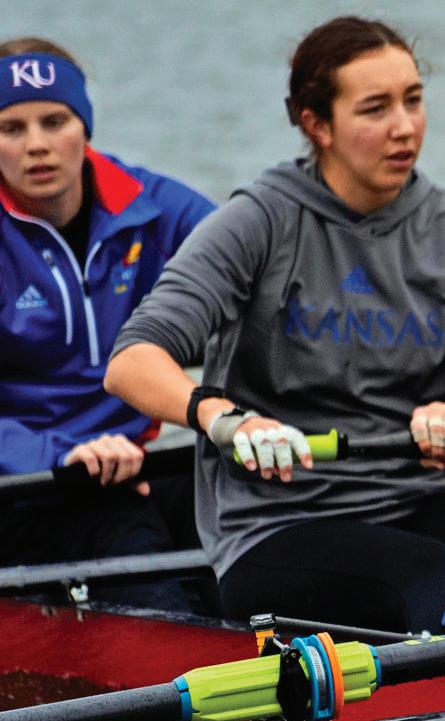

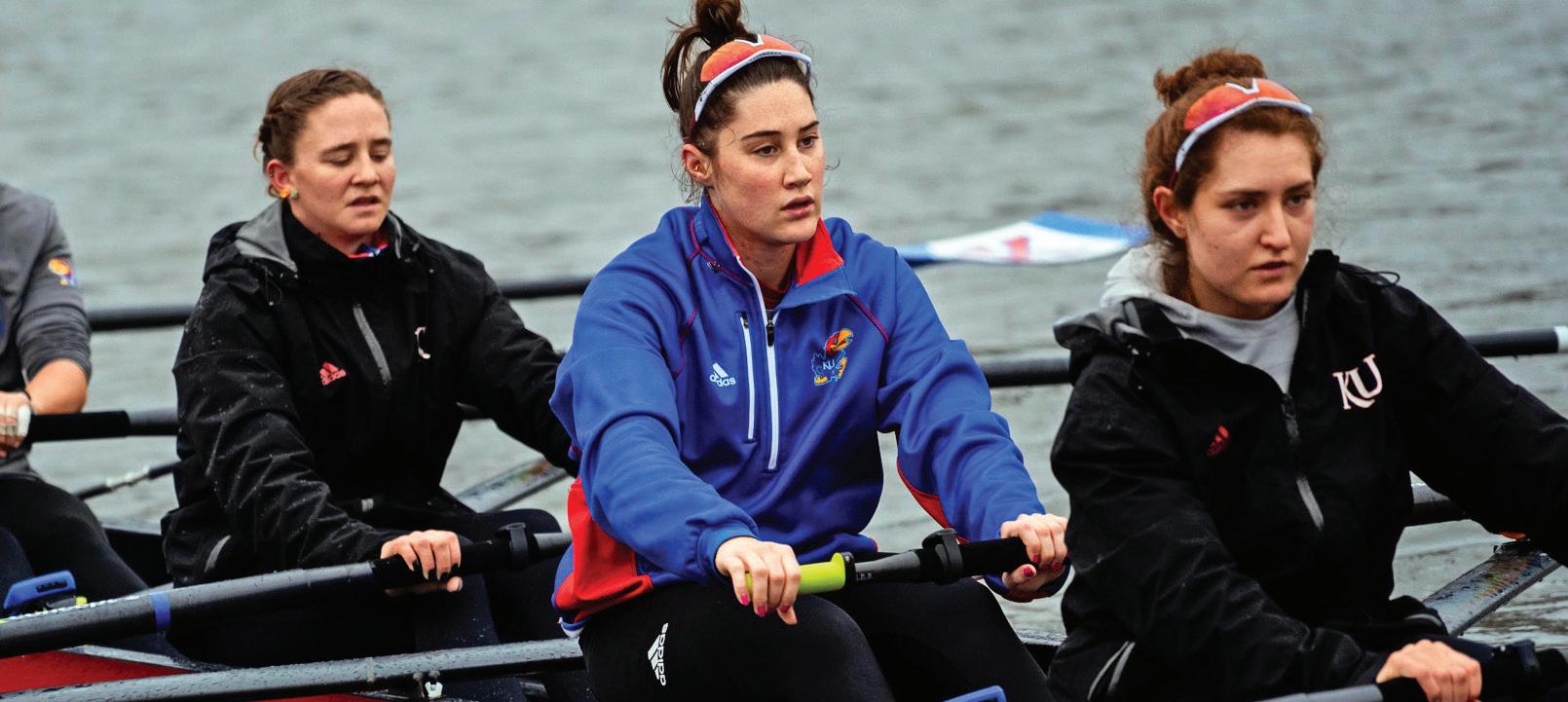


DATE
Oct. 18 Late Night in the Phog Allen Fieldhouse
Oct. 29 Washburn (Exhibition) Allen Fieldhouse
Nov. 4 Howard Allen Fieldhouse
Nov. 8 North Carolina Allen Fieldhouse
Nov. 12 @ Michigan State State Farm Arena, Atlanta, GA
Nov. 16 Oakland Allen Fieldhouse
Nov. 19 UNC-Washington Allen Fieldhouse
Nov. 26 Duke Vegas Showdown, T-Mobile Arena, Las Vegas
Nov. 30 Furman Allen Fieldhouse
Dec. 4 Creighton Big 12-Big East Battle, CHI Health Center, Omaha, NE
Dec. 8 @ Missouri Missou Arena, Columbia, MO
Dec. 14 NC State Allen Fieldhouse
Dec. 22 Brown Allen Fieldhouse
Home Opponents Only Arizona, Arizona State, Oklahoma State, Texas Tech, West Virginia
Road Opponents Only BYU, Utah, TCU, Baylor, Cincinnati Home-and-Home
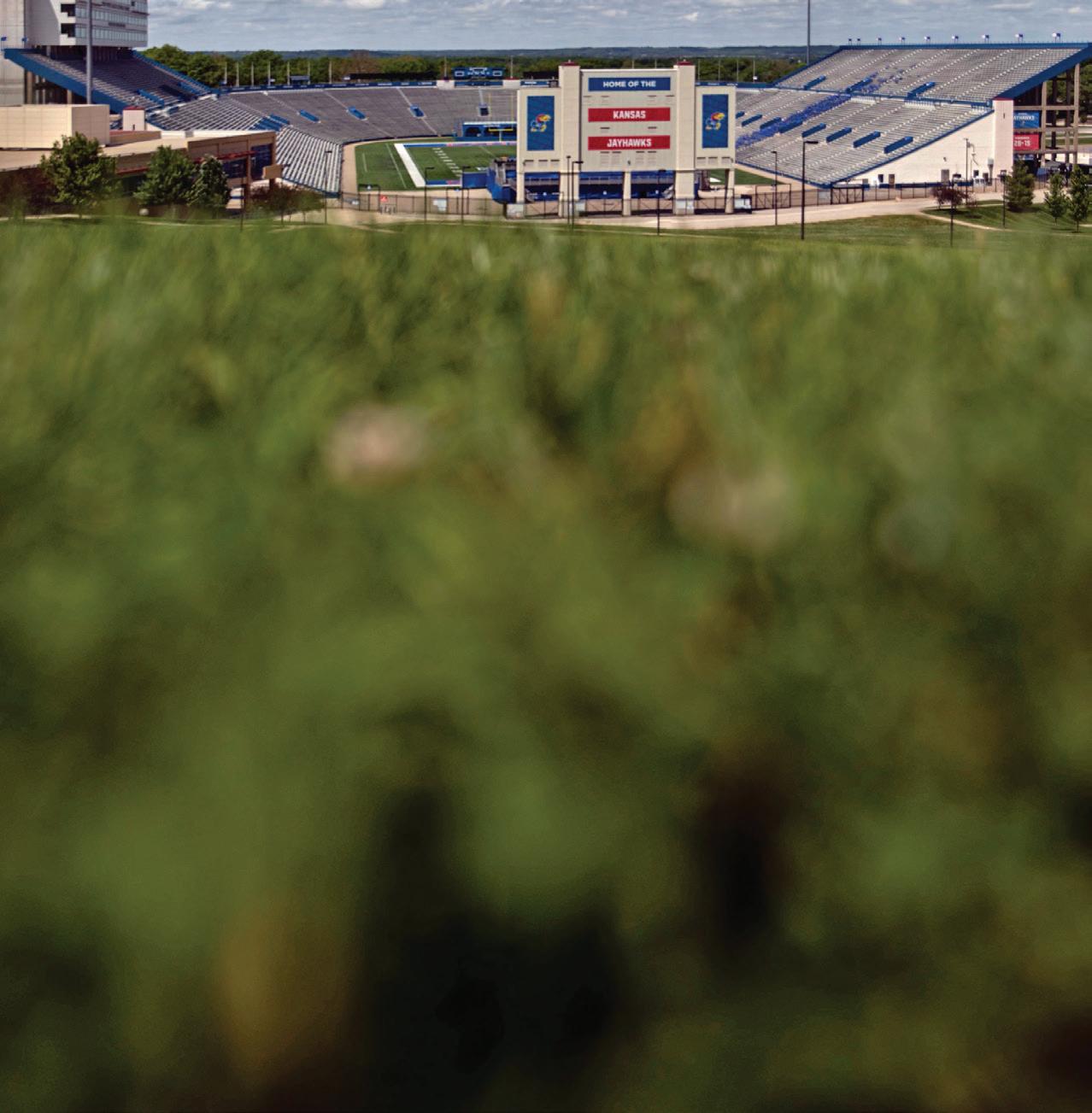
Rupp Arena, Lexington,






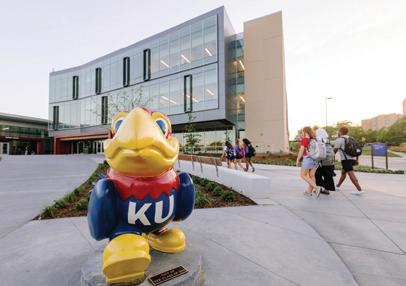


Let Jayhawk Hospitality host your next event.
Jayhawk Hospitality is your one-stop resource for planning, booking, and hosting your next event on KU’s campus or affiliated facilities. We offer:
• A variety of spaces
• A customizable catering menu
• Tech solutions to fit your needs
• And more Contact us today, and we’ll help you get started.